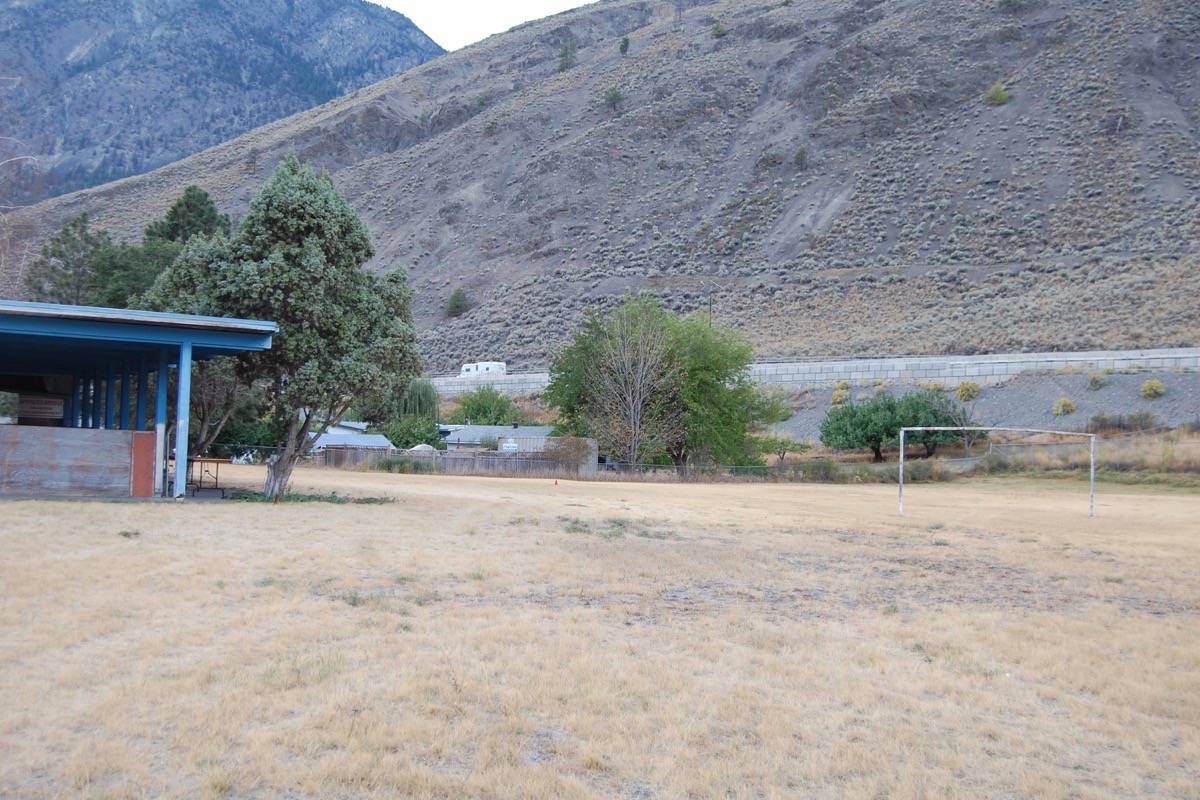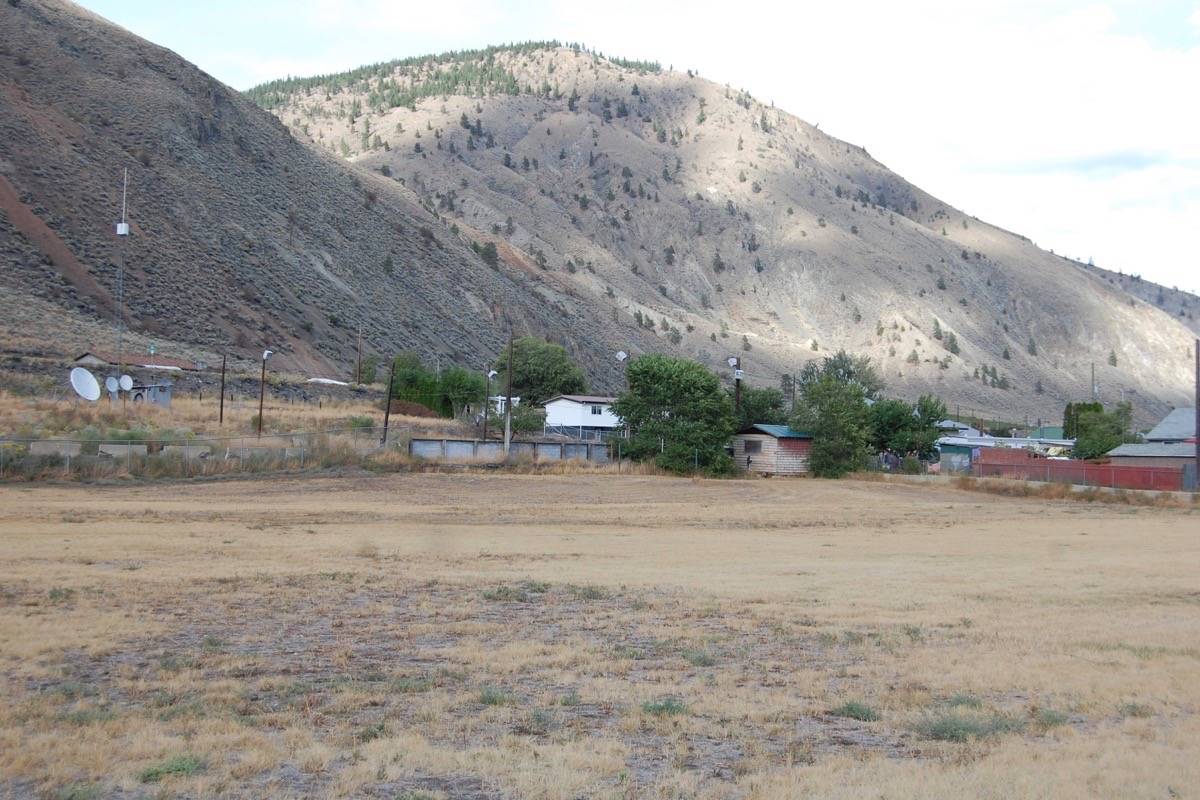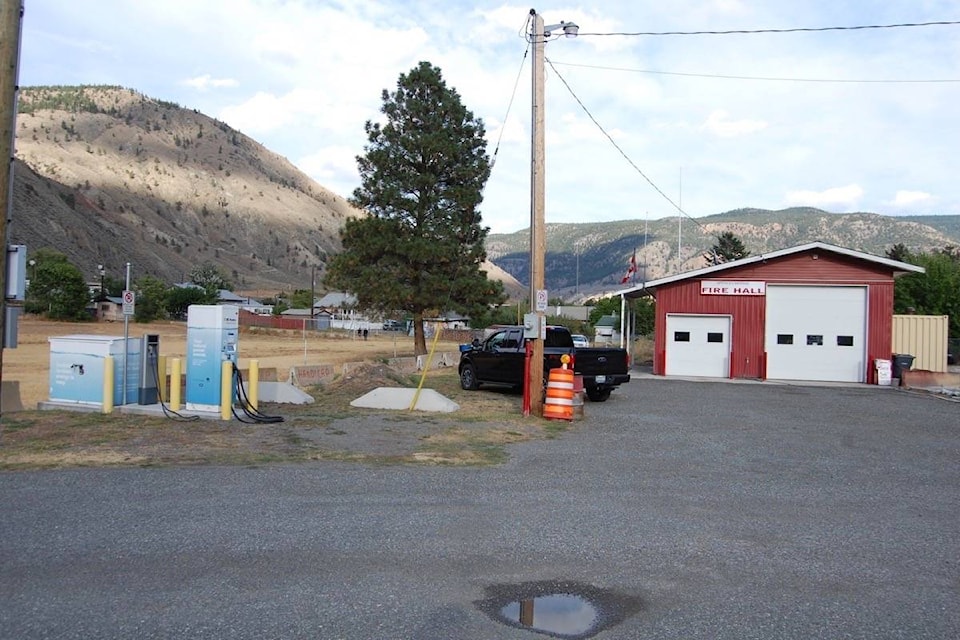The fate of the fast charging electric vehicle (EV) station in Spences Bridge is still up in the air, after a meeting of the Spences Bridge Improvement District (SBID) on Sept. 24 revealed a seemingly deep divide between the SBID board and the community.
At issue is the question of whether the benefits of having the station in town outweigh the purported costs. There is also disagreement as to whether the current site is the best one for the station, and questions were raised about the overall maintenance of the SBID building grounds.
BC Hydro installed the EV station beside the Spences Bridge fire hall and the SBID building (the former elementary school) in 2016, in an agreement involving BC Hydro, the SBID, and the Thompson-Nicola Regional District (TNRD). Michael Jefferson, chair of the SBID board and one of its three trustees, says that under the terms of that agreement, the SBID leased the charging equipment to the TNRD for $1 a year for five years, and the TNRD entered into a land tenancy agreement with the SBID on the same terms.
BC Hydro now wants to negotiate directly with the SBID, this time for a 10-year land lease term at $1 per year. However, Jefferson and the other trustees are asking BC Hydro to install a washroom, citing concerns about people urinating and defecating at the site. They also have concerns about the SBID having to take responsibility for security, maintenance, and garbage and snow removal at the site.
“The Spences Bridge Improvement District cannot subsidize BC Hydro,” says Jefferson. “Taxpayers and local hosts are subsidizing charging stations and electricity costs, and legally we can’t do that. The SBID is governed by letters patent that give it the taxing authority for parcel tax charges to residents [to pay] for fire services and [maintenance of] 31 streetlights. This land tenancy agreement was very one-sided.”
Jefferson says that while the SBID supports the station in principle, they countered the new offer with one of their own, asking BC Hydro to pay the SBID $15 per day ($5,475 per year).
“We can’t tax that land. [The funds] could be credited to the bill we get for streetlights, and we could hire a maintenance person to keep the place clean. We also want some paving around the fire hall, because the station is on rough unpaved ground with gravel and weeds, and want Hydro to build some rest area-style washrooms with flush toilets that are heated all year round, which the SBID would maintain.
“BC Hydro said ‘That’s not part of our business plan, we don’t do that.’ We said ‘The ball’s in your court, make it work or take it out.’”
Alec Tsang, in charge of EV Infrastructure Planning for BC Hydro, says that the current business model for the Spences Bridge station is in line with their arrangement in other communities.
“We get a lease for the land. These sites are a loss leader, and we try to minimize the cost because of our stakeholders. We bring something to the town by investing in a charging station, which is for the use of residents and travellers. It brings visitors to the town, to stop and refuel their vehicle, which is a free-for-use service.
“The maintenance and operation of these stations is costly because they’re fairly new and the operating costs are quite high. We try to avoid costs where we can, to be responsible to our ratepayers. We’re trying to work with the community so we can stay in town with that station and see what kind of agreement we can come to that works for them and us.”
Tsang acknowledges that the lack of a washroom is the main stumbling block.
“That’s the biggest issue. It’s not in our mandate to provide washrooms at our stations, so we try to partner with associates, but there’s no such thing as 24-hour service in small communities. Other communities have managed with that situation, and it’s an issue that could make or break this.
“The position we landed on, since we couldn’t find a solution, is that we considered leaving on Nov. 1. Since then the supporters of the station have come back to us saying they don’t want us to leave, so we’re open to what would work for us to stay. We’re looking to work with all stakeholders to work it out and see if there’s a way forward.”
At the Sept. 24 meeting, 17 residents of the tiny community were on hand, and those who spoke expressed support for keeping the station, noting the economic benefits of attracting more travellers to stop in Spences Bridge and make use of the businesses and amenities there. They also expressed frustration at the way in which the SBID is dealing with BC Hydro, with one person noting that there should be negotiation, not demands.
When Jefferson suggested that the SBID was amenable to the station being removed from their land and relocated, several people noted that it made no sense to move the station to another site. A letter and petition from the Spences Bridge Community Club asking for the station to remain was not on the agenda as correspondence, despite being sent in time for the cutoff for agenda items, and was eventually added. The letter asked for a motion stating that the SBID would reverse its decision to ask for the removal of the EV station, and the motion was made but defeated, with trustee Cheryl Klyne voting in favour of the motion and Jefferson and third trustee Ross Figley voting against it.
One member of the audience produced a letter from the TNRD stating that it was willing to construct a washroom at the current site. Jefferson said he had not seen that letter, but that the trustees would look into it. To repeated statements from the gallery that the EV station was good for the town and brings business, Jefferson said the trustees had asked themselves “What’s in it for the SBID?” and that the answer was “Nothing. If businesses want it, they can subsidize it.”
“We the taxpayers want it,” said someone in the gallery. Other comments from the gallery included “You’re not representing the community”, “You’re not hearing the community”, “You’re finding reasons to fight with the community”, and “The EV station is an asset and adds to the village, we want it to stay.”
Another issue raised was the condition of the grounds of the SBID building: the lawn has died, and several trees are also dying. The grounds are maintained by the Spences Bridge Fire Department, of which Figley is in charge, and Jefferson said that the sprinkler system was tampered with in 2018. Figley said there was video of the alleged perpetrator, then appeared to contradict that statement (Jefferson said he “had not heard” about a video), and it was stated that a file was created by Lytton RCMP.
When someone in the gallery asked why no charges were laid, Jefferson replied that the RCMP had determined that what had been done was an “act of good faith”. According to an RCMP source, this means that the person was deemed to have acted in a manner designed to help or make better the situation, not harm it.
Several people expressed disappointment in the state of the grounds, describing the lawn and trees as a “gem” when they are maintained. Jefferson said that the lawn would need to be leveled and re-seeded, and someone asked why, if there was money in the bank, the system could not be up and running again. “That’s up to the chair; I don’t care,” replied Figley.
“The field is a gem, I agree 100 per cent,” said Jefferson. He said the sprinkler system is in full working order following the alleged vandalism in 2018: “There is a new control box, there are new sprinkler heads, and it was flushed out in 2018.”
This appeared to contradict a statement by Figley earlier in the meeting, when he said there was “no time” to fix the system. When asked why the sprinkler system had not been turned on in 2019 or 2020, if it was in working order, Figley replied “I didn’t feel like turning it on. I have my own stuff to do.”
The next meeting of the Spences Bridge Improvement District — at which members of the public are welcome — was set for Thursday, Oct. 22. After complaints from the gallery about the time of the Sept. 24 meeting — 2 p.m., which precluded many working people from attending — the time of the next meeting was fixed for 7 p.m. at the SBID building.
editorial@accjournal.ca
Like us on Facebook and follow us on Twitter


